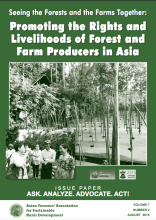/ library resources
Showing items 1 through 9 of 13.Shared Assets works with landowners and social and community enterprises to develop innovative ways of managing land for the common good, be it parks, farmland, woodlands, waterways, or other spaces. We also look for ways to create an environment that allows these models to thrive.
At Shared Assets we believe that land is a common resource and that it should be made to work for everyone. This means using land to generate social, environmental, and economic value.
This report explores some of the key issues to consider when supporting new land-based social enterprises. The findings are drawn from interviews with 13 representatives from social enterprises who received direct technical, business and training support from Shared Assets between 2013-15.
There is a very close relationship between forestry and farming. Both forests and farms are source of food (both from plants and animals), nutrition, health, and livelihoods for family farmers. Besides, forests provide sources for fuel, energy, water and medicines.
As opposed to agribusiness or corporate farming, FAO defined family farming as “a means of organizing agricultural, forestry, fisheries, pastoral and aquaculture production which is managed and operated by a family, both female and male.
In 2008, Ka Lita, a woman rice farmer in the Philippines, stood in a long line to buy rice that was being sold by the National Food Authority (NFA), the government’s rice trading agency.
The issue of climate change was already being discussed in the 1980s as scientists raised alarm over the world's increasing emission of manmade green house gases (GHGs), the main cause of global warming.
Our unsustainable way of life is causing a crisis in our environment at a global scale. Climate change is threatening the future of our planet. The crisis is largely our own doing, and we also have the means to solve it, if we are willing to act on it.
The agri food system across the globe is fast restructuring.
Pagination
Land Library Search
Through our robust search engine, you can search for any item of the over 73,000 highly curated resources in the Land Library.
If you would like to find an overview of what is possible, feel free to peruse the Search Guide.









